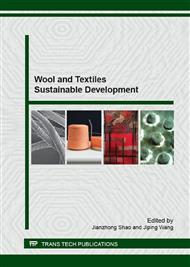[1]
Chen, X. F., Progress of researches on dyeing with natural tea dyes. Journal of Silk. 2012. 49(09): pp.13-17.
Google Scholar
[2]
Liu, J., Study on the Dyeing of Wool Fabrics with Phytolacca Berry Natural Dyes. Fibers and Polymers 2014. Vol: pp.1601-1608.
DOI: 10.1007/s12221-014-1601-1
Google Scholar
[3]
Singh, R., Antimicrobial activity of some natural dyes. Dyes and Pigments 66 (2005) 99-102.
DOI: 10.1016/j.dyepig.2004.09.005
Google Scholar
[4]
Hasan, M.M., Dyeing of Cotton and Silk Fabric with Purified Natural Curcumin Dye. IJSET 2014. July: pp.838-844.
Google Scholar
[5]
Luo, Y.L., Dyeing technology of real silk with the natural curcumine. Advanced Materials Research Vols. 881-883 (2014): pp.122-124.
DOI: 10.4028/www.scientific.net/amr.881-883.122
Google Scholar
[6]
Guizien, K., Microorganism dynamics during a rising tide: Disentangling effects of resuspension and mixing with offshore waters above an intertidal mudflat. Journal of Marine Systems, 2014. 129: pp.178-188.
DOI: 10.1016/j.jmarsys.2013.05.010
Google Scholar
[7]
Sandmann, G., Genetic manipulation of caroteneoid biosynthesis: strategies, problem and achievements. Trends in Plant Science, 2001. 6(1): pp.14-17.
DOI: 10.1016/s1360-1385(00)01817-3
Google Scholar
[8]
Gupta, D., Mechanism of dyeing synthetic fibres with nature dyes. Colourage, 2000. 8(3): pp.23-26.
Google Scholar
[9]
Jing, Y.U., et al., The present situation and the development of natural dye application. Wool Textile Journal, 2005. 4: pp.24-27.
Google Scholar
[10]
Cheng W.L., The dyeing process of red yeast rice on silk. Dyeing and Finishing Additives, 2000. 17(5): pp.22-25.
Google Scholar
[11]
Zhu S.M., Separation and determination of ginkgo endophytes. Journal of Zhongshan University Graduate Student. 2011. 32(4): pp.64-74.
Google Scholar
[12]
Qiu, M., Isolation and identification of endophytic fungus SX01, a red pigment producer from Ginkgo fungus SX01, a red pigment producer from Ginkgo biloba L. World J Microbiol Biotechnol, 2010. 26: pp.993-998.
DOI: 10.1007/s11274-009-0261-6
Google Scholar


